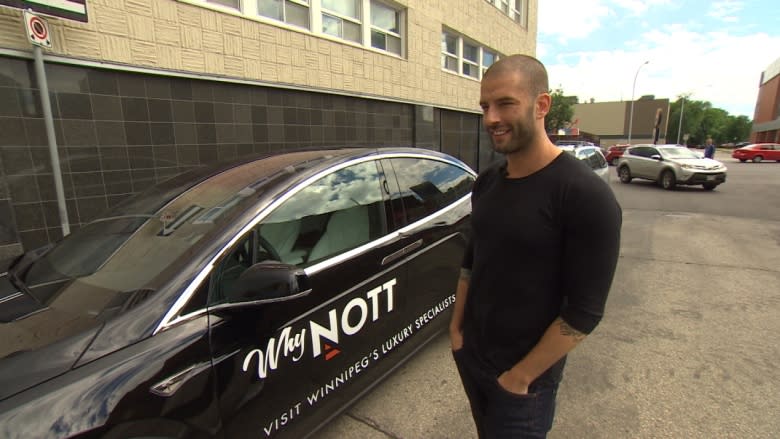'It's insane': Magician Darcy Oake test drives 'driverless' car on Winnipeg streets

Darcy Oake has been getting a lot of head turns from drivers and pedestrians over the past few days on Winnipeg streets.
The Winnipeg magician has been driving a borrowed electric Tesla Model X around the city — one of the few self-driving cars currently on the streets of Winnipeg and Western Canada.
"It's insane. I feel like it's artificial intelligence."
"It senses everything around, it drives itself, it parks itself, it can come pick you up, it's kind of freaky," he said while taking CBC for a ride-along Tuesday afternoon. He estimates he's driven about 200 km since borrowing the car on Monday.
With the touch of a button, Oake can put the vehicle into self-drive mode, using sensors on the exterior to monitor the painted road lines and the speed and distance between other vehicles. But while it may be tempting to watch a movie or perhaps read a book, as Oake did in a tweet Tuesday, he advises against it.
"You're really not supposed to take your hands off the wheel when you're [using self-drive mode]," he said. "But yeah, people don't seem too thrilled to see somebody reading a book while they're driving a car."
Manitoba Public Insurance agrees.
"Despite vehicle automation features, a driver is required to have physical control of the vehicle at all times while in motion," an MPI spokesperson said in an email.
"As such, all existing laws and road rules pertaining to vehicle operation and driver requirements continue to apply."
The vehicle also has an "insane" mode, which will speed up the car from 0 to 60 km/h in just 2.85 seconds.
Automation feature not perfect
But while packed with 21st-century technology and features, the vehicle's automation feature isn't perfect. It can't sense intersections or red lights, meaning the person sitting in the driver's seat still has to keep their hands on the wheel and foot near the pedals to intervene.
"Putting it on auto-pilot doesn't mean, 'Completely disregard your surroundings and do whatever you want,' right?" he said. "You still have got to concentrate on the road."
The self-driving autopilot feature in Tesla cars, which uses a combination of cameras, radar, ultrasonic sensors and data, has been making news for the wrong reasons in recent weeks.
On Tuesday, Tesla CEO Elon Musk promised a new "masterplan" for the company, following reports of a third vehicle in as many weeks getting into an accident while the self-driving mode was engaged.
In May, 40-year-old Joshua D. Brown of Canton, Ohio, was the first U.S. driver to die in a collision involving a car in self-driving mode.
He was killed in Florida when the cameras on his Tesla Model S sedan failed to distinguish the white side of a turning transport truck from a brightly lit sky and didn't automatically activate its brakes.
It also can't sense construction or barricades. Oake also isn't sure how it might handle in a harsh Winnipeg winter, with ice, snow and road lines that might be hidden.
"I probably wouldn't advise the self-drive mode in a Winnipeg winter," he said. "I feel that would be a roll of the dice."
Faded road lines also pose a challenge for the vehicle's sensors.
Self-drive has limits
"The self-drive option doesn't work to its full capacity here in the city just because the paint on the roads is a little worn away," he said. "In other major cities, apparently it works flawlessly. It does here as well, just not necessarily as well."
On a brief drive around Winnipeg, the car did manage to detect vehicles that were stopping on a busy Portage Avenue mid-afternoon and stayed in its lane, even when manoeuvring around a slight curve in the road.
On the road, Oake said he has seen other drivers slowing to a crawl to film the vehicle, which resembles a spaceship. Someone even stopped by his house on Tuesday after seeing the car parked in his driveway.
The car is owned by Trevor Nott of Winnipeg's Nott AutoCorp. A company spokesperson said two are currently in stock in the city and eight have been sold since 2014.
Criticism from police
The fact that some drivers may be relying too heavily on the technology is drawing criticism from Winnipeg Police.
"You're putting a lot of faith, your life and other people's lives in that technology," said Winnipeg Police Staff Sgt. Rob Riffel. "I just don't think that technology is here yet."
Riffel said had he seen Oake reading a book behind the wheel, he could have been in some trouble.
"I would have stopped him for sure," he said. "Depending on what was going on at the time on the roadway, a charge of careless driving could be laid."
"It's a driver-assist system. It's not a drive by itself system."
Riffel believes the technology isn't being used enough in Winnipeg to warrant changing laws, but it could be something to look at when the technology becomes more prevalent.


